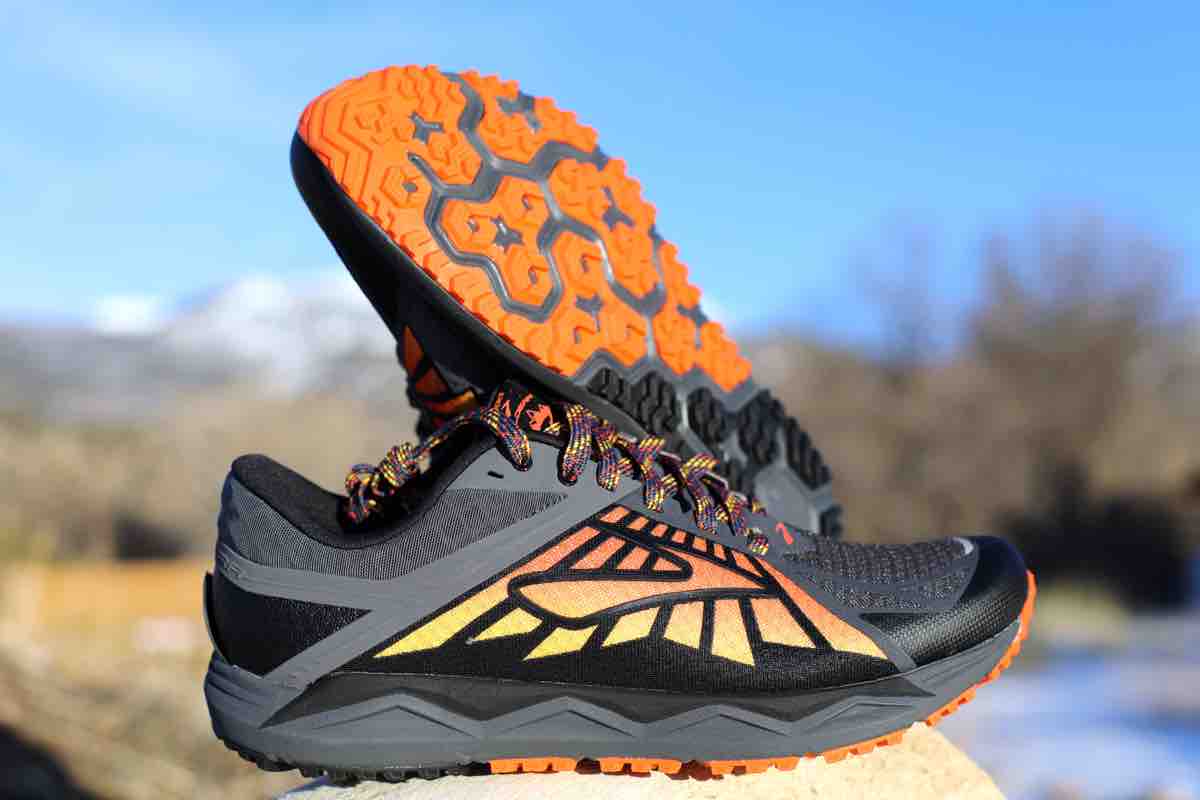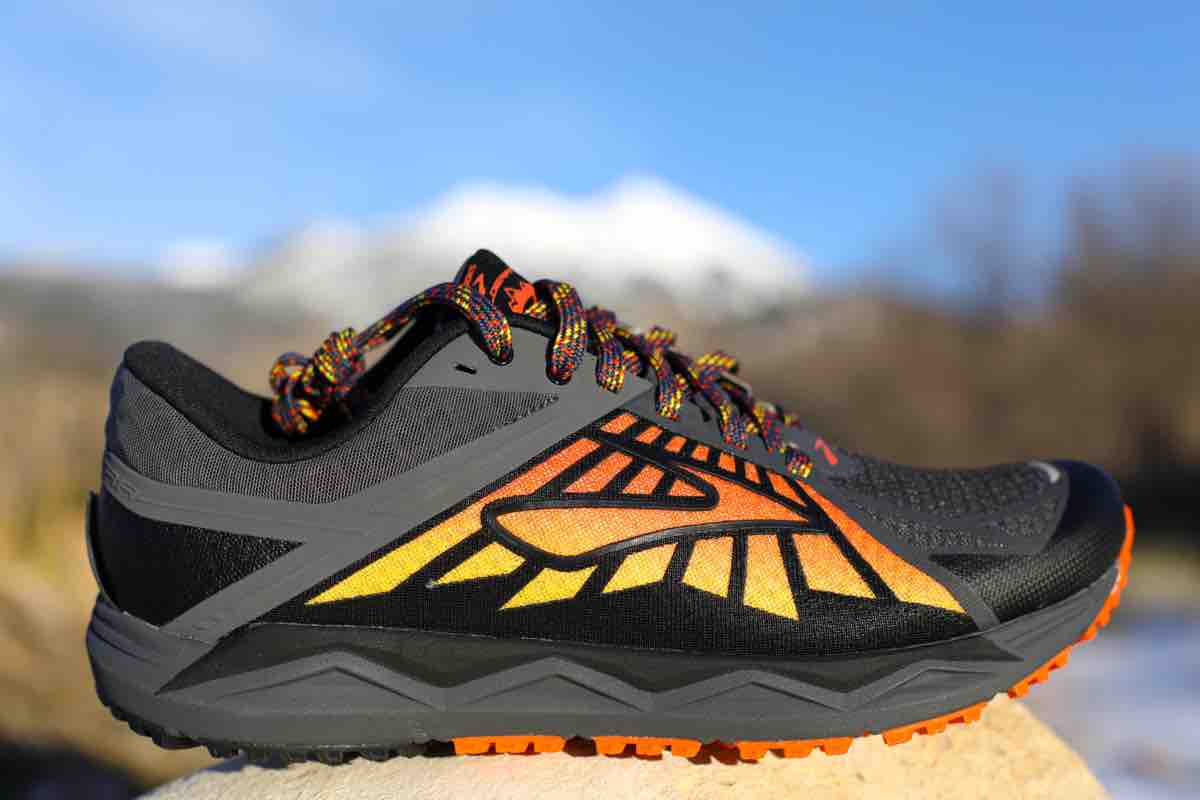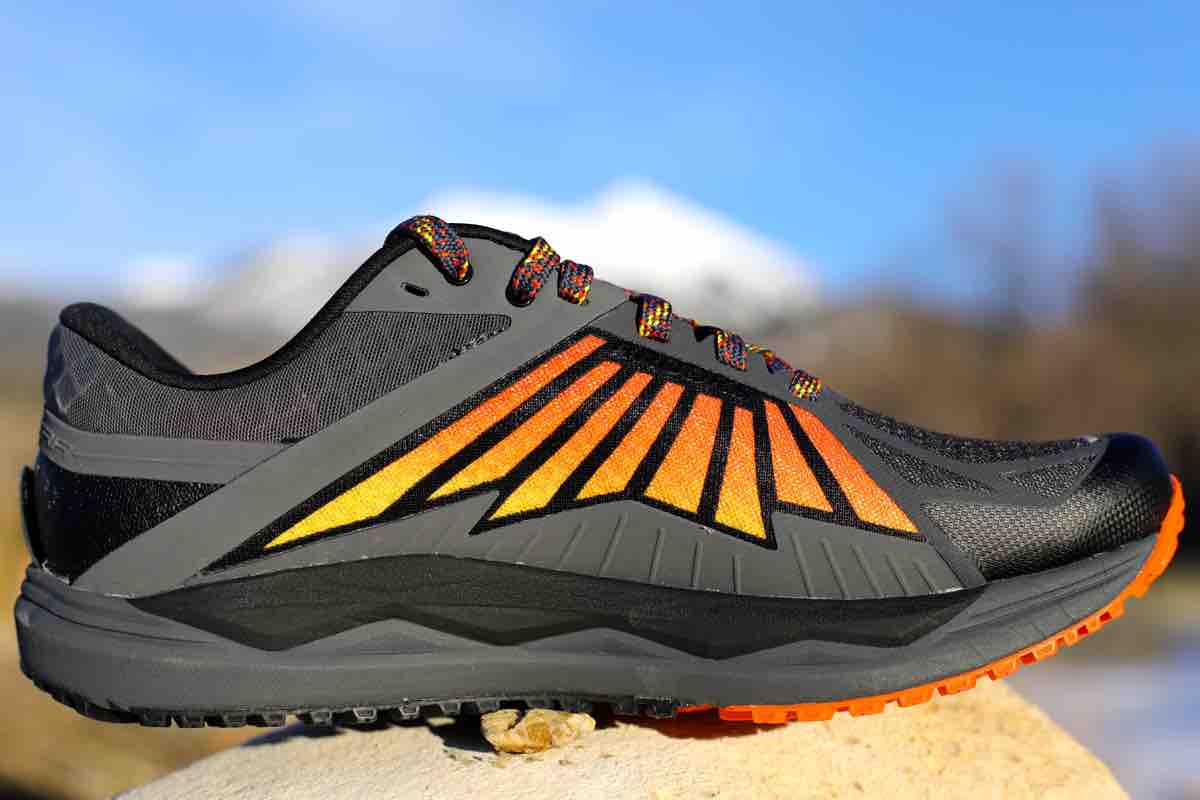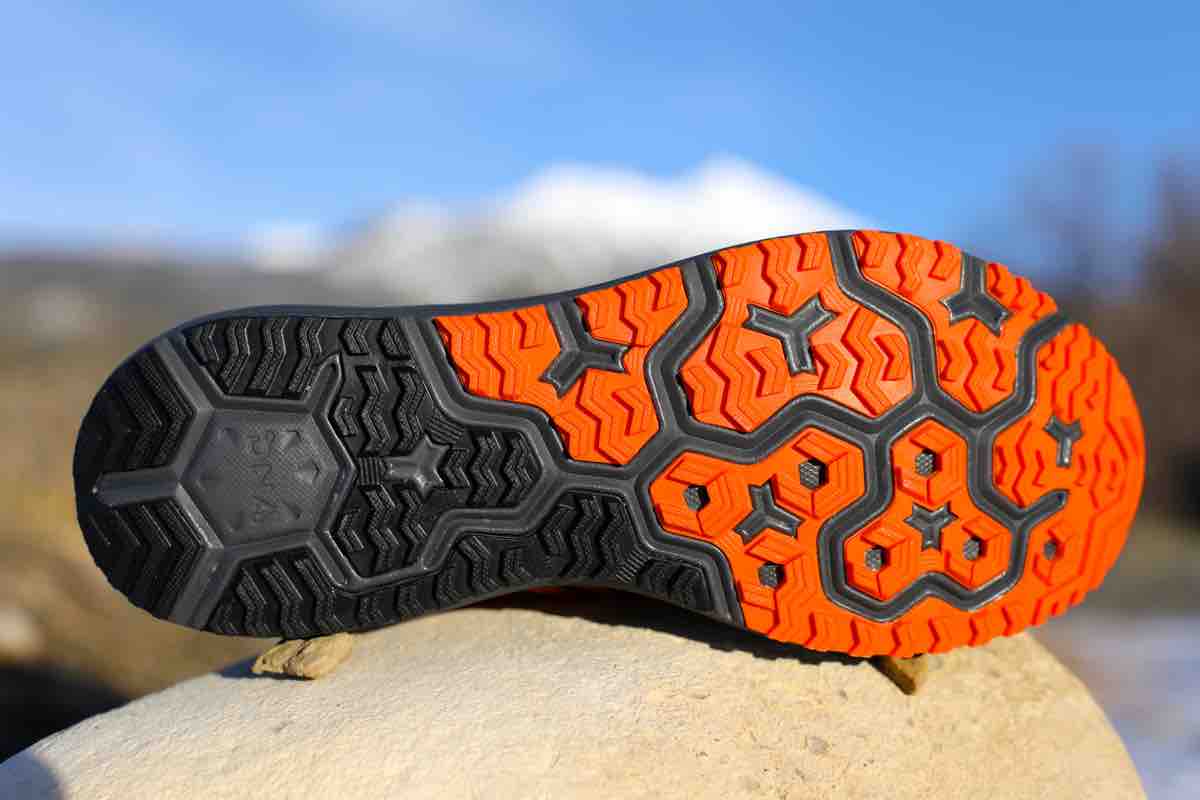Check out our Brooks Caldera 8 review for the latest on the Caldera family of trail running shoes.
Our Favorite Trail Running Shoes
Check out our Best Trail Running Shoes article to learn about our current favorite trail running shoes!
Brooks Caldera Review
Brooks has been one of the major shoe companies who has been in the trail running game for a long time. In fact, you’d be hard pressed to go to a race or even a group run and not spot a pair of Cascadias. However the Cascadia doesn’t really match today’s trends, leaving a large portion of the market unaccounted for. Enter the Brooks Caldera ($140). The 9.9-ounce Caldera is a higher-cushioning and lower-drop model in its first version looking to appeal to those wanting a softer platform that rides low. A secure upper matched with surprising grip makes this shoe a great all-around option for everything but the nastiest of conditions.
Brooks Caldera Review Transcript
Today we’re going to be taking a look at the Brooks Caldera. This is a 9.9-ounce 4mm drop shoe that is considered, in terms of Brooks, a higher-cushioned shoe. This is probably what a lot of people would have expected the Cascadia to turn into over time. Brooks decided to make a new model of it. This is version one. Let’s get up close and personal and see what this shoe is all about.
Brooks Caldera Upper
We can dig into the upper first, and I think when we kind of look around through this, we’ll see it’s a fairly constructed upper, meaning it’s not just simple mesh. There are quite a few overlays and those kinds of things around the shoe. We can start at the toebox. If you look at this and kind of look at the width of it, it’s kind of wider and doesn’t come to a severe point, which I think is good for toe splay and for people who have a little bit of a wider forefoot or want more room for their toes to wiggle. It’s not a big pronounced toebox so you feel like your feet are swimming in it either.
Throughout the upper, we have these overlays, which of course are very common these days in terms of adding structure to a shoe without adding a bunch of stitching. There’s not a lot of stitching through here. Looking at it closer, there doesn’t appear to be any. A lot of this is just the overlay material. You’ll see that coming from these different areas, and then just like we’ve seen on a lot of other shoes, there are anchors here at the laces area, which allows for good grip and locking down of your foot. I felt like this shoe was fairly stable and good at locking my foot down specifically in the midfoot without being too tight and definitely was not a sloppy feel, which is nice because it is a little bit taller of a midsole, so it’s good having that locked-in feeling.
What you’ll notice is a little bit of this mud guard throughout. We can see along here through the lateral side, all the way through the toe, and even here on the medial side is some rubberized material, some cloth, all the way through that really keeps some debris from getting in. The other nice thing about this is it adds a little durability to some of these points that tend to add up and be those stress areas. With that said, though, if you kind of look here in this area and here in this area, you’ll kind of see this bend zone, a little bit of wear and tear that is popping up. In fact, it’s kind of puckering right here above this little rubbery overlay. It could be causing even a little more of that than normal.
Pretty standard lacing, flat laces—one of the things I liked about this is that the lace [holes] are metal up toward the top. I think the laces slide through there a little bit easier when they get dirty. They don’t get hung up. It adds a little more durability to it. Looking at the back, we have a gaiter-attachment area. I don’t use gaiters, but if you do, you’ll be happy to know this exists. In the back, it’s a good medium-cushion heel collar here—not a ton, but again, I feel like this is a good shoe with fairly good stability throughout. We have a lace garage which I have not used, but you can tuck your laces into if you don’t use your laces as much as I do and they’re out flopping around. Then, you have a gusseted tongue that starts right here, just below the fourth eyelet, all the way down, to keep that debris from getting inside of your shoe. So it’s a fairly standard upper, but definitely in terms of the Brooks I’ve worn in the past, it’s definitely a more locked-down feel than those I’ve worn previously.
Brooks Caldera Midsole
As we move our way to the midsole, this is kind of where a lot of other reviews online have talked about this being a max-cushioned shoe. Where there’s more cushion, I don’t know that I’d consider it a max cushion. It’s definitely a medium cushioned or slightly above medium cushioned stack in general throughout the shoe. They use the BioMoGo sole throughout. It is a neutral cushioning, so there’s not any extra blocks or anything like that or area added of density to do something with pronation. It’s a very standard midsole. I felt like it performed well and my foot laid fairly flat or even inside of the shoe. I didn’t feel like it was pronating or supinating one way or another when standing flat. It’s a very nice, responsive midsole. I don’t think there is a trail rock plate in here. I couldn’t really find anything anywhere that said anything about it. It definitely does not feel like there is one inside of here when you feel around. With that said, though, you kind of have enough cushioning and the way that this cushioning is created, unless it’s something really sharp and you hit it really impactful[ly], I didn’t notice anything stabbing. I ran in these on a lot of technical terrain and never felt anything popping through or pushing or anything along those lines. Again, it’s a very responsive midsole with extra cushioning for those people who are wanting a little bit more cushioning but aren’t looking for a fun maximized type of shoe.
Then it has a little bit of this rocker bend. So if you look at it throughout the shoe and especially here at the toe, you see it kind of ramps up. It has that rocker feel that is becoming much more common in the trail running shoes.
Brooks Caldera Outsole
Then as we roll our way down to the outsole, I’d say this is probably the most surprising part of the whole shoe for me. It’s a very low lug depth, but these were very sticky. So a lot of rain and mud and moss and wetness throughout the Pacific Northwest this year, I wore these a lot even in the snow and felt like traction wasn’t really an issue except in the most extreme conditions. Even though it’s a little lower lug height and it doesn’t even take up the whole shoe—you can see these cutouts for weight savings—these performed really, really well. Again, I was surprised how well these did across a variety of conditions. Looking at the lugs specifically, you’ll notice the common thread that exists on most trail running shoes is the uphill climbing lugs that allow for traction up, and as you transition toward the middle, you kind of see them going both ways, which is an interesting tread pattern. Here in the back, we start moving toward the reverse lugs for downhill braking. Then you can see some spots here in the middle where there aren’t any tread or outsole at all. Long term, maybe you have a bit of extra wear and tear in these types of areas, but these shoes have over 100 miles in them, and I’d say in general they’ve held up really well.
Lastly, on the toe-bumper side of things, we have a little bit of this laminate overlay here at the front that is a little bit plastic or vinyl feeling, semi-structured. Of course the outsole wraps itself around giving it actually a lot of a hard point right here at the very tip. Again, stubbing my toes is not something I noticed too much of. With that, let’s go back to final impressions.
Overall Impressions
In closing, this was a really surprising shoe for me from Brooks. I’ve worn Brooks over the years, and they kind of fell out of favor with me because of the ride and some of the other things that just didn’t seem to fit my foot quite right. I think for a first version of this shoe, it’s really excellent. It’s not too tall of a stack height, but it’s also not too low, which means it transitions really well from trail to road running alike—kind of a hybrid type of shoe. Then the traction was surprising. Everything except the most extreme wet and slick type of environments, this thing did a really good job especially for as low as the lug height is. It rides well. It fits well. The only thing I’d say is in my shoes that have 100-some-odd miles in them, as well as talking to some other trail running friends who have worn these, some of them are having a little durability issues in some of these spots. Outside of that, it doesn’t seem to be in any of the major areas. Overall, it’s holding up really well.
Questions or comments? Leave those below the video. Thanks for watching. We’ll catch you next time.
Call for Comments (from Meghan)
- Have you run in the Brooks Caldera yet? If so, what are your overall thoughts on the shoe?
- What do you think about the traction provided by the outsole? Have you found it to be as good as iRunFar reviewer Travis has?
- Have you run in recent versions of the Brooks Cascadia? If so, how would you say the Caldera compares to the Cascadia?
[Editor’s Note: If you’re affiliated (i.e., an employee, ambassador, etc.) with a shoe brand, please share your relation in each of your comments on this article. Thanks!]




